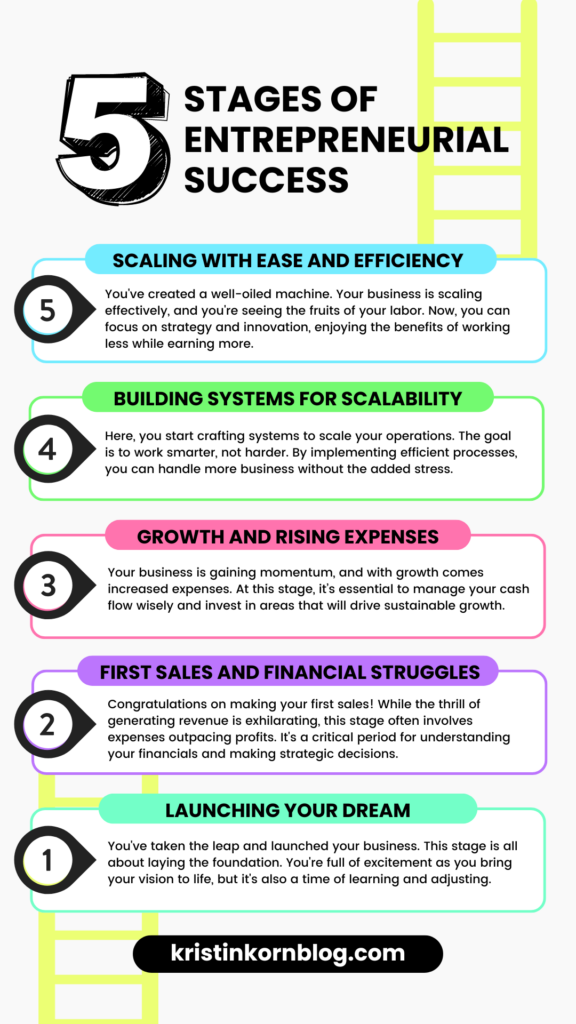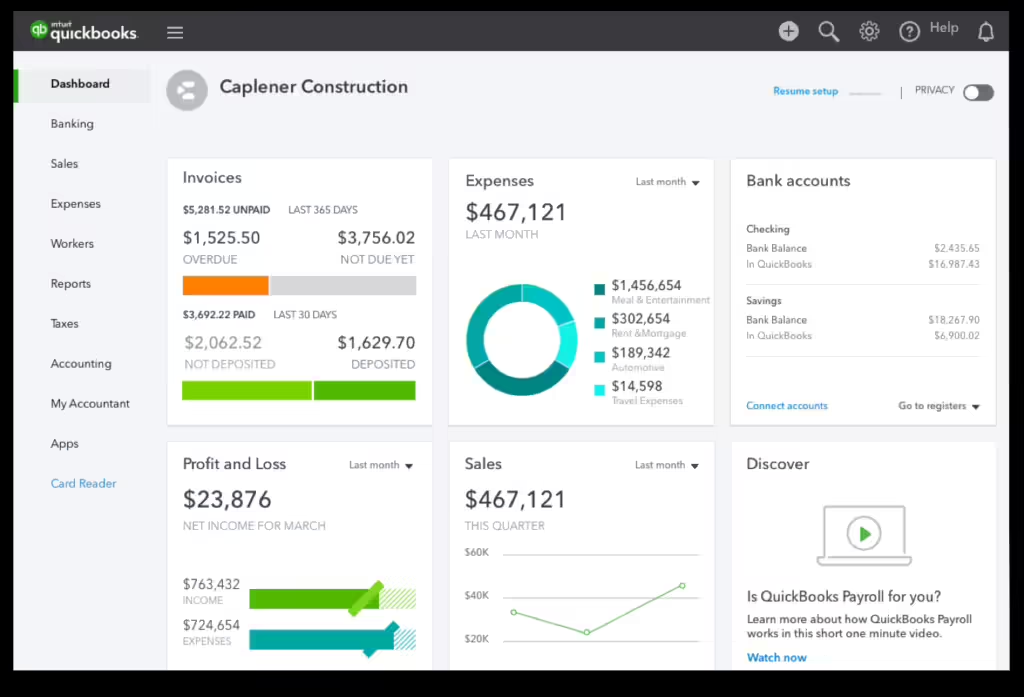Starting a business is such a thrilling adventure, isn’t it? 🌟 It’s packed with endless possibilities and a fair share of challenges. Every entrepreneur moves through different stages of business growth and development, whether you’re just starting out or have years of experience.
Understanding these stages isn’t just helpful—it’s crucial for long-term success. Each phase brings unique situations, and mastering them can provide you with the mindset and tools needed to thrive.
In this article, I’ll walk you through the five key stages of entrepreneurial success, from launching your dream to scaling with ease and efficiency. As you dive into this journey, remember that every step you take is a testament to your resilience and dedication to your vision.
Think of this road map as your companion, empowering you to stay focused, adapt when necessary, and celebrate each milestone with confidence. You’re not just building a business; you’re creating a legacy. And trust me, you’ve got what it takes to make it happen. 💪✨
Table of Contents
From Trials to Triumph: My 20-Year Entrepreneurial Success
My entrepreneurial journey has been a winding path full of trials, triumphs, and transformative experiences over the past 20+ years. My latest adventure started with the excitement and vision of launching my marketing business in 2020. Along the way, I’ve faced the challenges of managing finances and growth, and ultimately, I’ve learned to create efficient systems that allow my business to scale with ease.
Each stage demanded unique skills and mindset shifts, and I found myself continually learning, adapting, and persevering. That’s why I think it’s so important to share the emotions and what’s needed to move through each of these stages.
Have you ever felt that the road ahead is uncertain? I certainly have. But through every setback, I discovered new strengths and insights.
Embrace each moment, both the highs and the lows. They all contribute to your growth. Remember, it’s okay to struggle and it’s okay to ask for help. We’re all in this together, learning and growing every step of the way. 🌱
Importance of Understanding and Navigating Different Stages of Business Growth
Understanding the different stages of entrepreneurial success is crucial in effectively managing your business’s growth and sustaining long-term success.
Each stage brings its own set of challenges and opportunities.
Remember those initial financial struggles? And what about managing escalating expenses during growth phases?
Recognizing these stages allows you to strategically plan and implement the right systems at the right time, ensuring you can scale your operations without feeling overwhelmed.
Have you encountered similar challenges in your journey? It’s all part of the process. By acknowledging these stages of business growth, we can navigate our paths more smoothly and reach our goals. Keep pushing forward—you’re not alone in this! 💪
Promise of Personal Growth and Business Development Through These Stages
Navigating through these stages isn’t just about growing your business—it’s also about personal development. This journey equips us with invaluable experiences, builds our resilience, and hones our problem-solving skills.
Every challenge we face and conquer deepens our self-awareness and strengthens our confidence. As we grow our businesses, we also grow as individuals, finding a fulfilling balance of professional and personal success.
Each step forward is a testament to our dedication and hard work, promising a rewarding experience both personally and professionally. 🌟
What Are The 5 Stages of Business Growth Explained?
By recognizing the challenges and opportunities inherent in each phase, you can better prepare yourself mentally and strategically. This journey not only teaches you about your business but also about your strengths and areas for improvement. It’s a path of self-discovery where every obstacle overcome builds your confidence and skills.
Moreover, having a clear understanding of these stages allows you to implement the right systems at the right time. Effective systems and processes are key to scaling your business sustainably. They help you manage growth without becoming overwhelmed, ensuring that your workload decreases as your revenue increases.
Stage 1: Launching Your Dream
Key actions: defining your vision, setting up legal structures, initial marketing efforts
Launching your dream business is one of the most exhilarating experiences you can have. The excitement of turning your vision into reality fills you with energy and motivation that pushes you forward. There’s a real sense of adventure as you lay the groundwork, develop your product or service, and bring your brand to life. Every small victory, from naming your business to securing your first customer, feels monumental and fills you with pride.
However, this stage isn’t without its challenges.
There are numerous hurdles to overcome, such as securing funding, managing a tight budget, and navigating the legal requirements of starting a business. The uncertainty of it all can be overwhelming, but it’s also a valuable part of the journey. Each obstacle you face teaches you something new about resilience, determination, and problem-solving.
Despite the highs and lows, remembering why you started and keeping your vision in mind can provide the necessary drive to push through. Embrace every moment of this stage; it’s the foundation upon which your future success will be built. 🌱
Stage 2: First Sales and Financial Struggles
Key actions: careful financial planning, maintaining cash flow, seeking mentorship
The thrill of making your first sales is unlike any other feeling. It’s a validation of your idea and a sign that others believe in your vision too. Those initial sales bring a rush of excitement and a deep sense of accomplishment. I remember the first time I saw an order notification pop up—it was proof that all my hard work was beginning to pay off. Each sale felt like a victory, and it provided the momentum to keep pushing forward.
However, the reality of financial imbalances soon sets in.
Despite the excitement of incoming revenue, managing finances at this stage can be quite challenging. Expenses can quickly overshadow income, and cash flow can become a significant concern. It’s easy to feel overwhelmed when juggling costs like inventory, marketing, and operational expenses, especially when trying to maintain growth.
During this period, I learned the importance of tracking my subscription and tool expenses on a Google Sheet and using QuickBooks to monitor my balance sheet.
It’s crucial to monitor your cash flow carefully and find creative ways to stretch your budget.
This stage taught me the value of taking the time to track expenses and looking honestly at what I was spending money on and why. Remember, it’s okay to struggle, and it’s vital to focus on sustainable growth while celebrating each milestone. 🌟
For a list of all the tools I use in my business – click here!
Stage 3: Growth and Rising Expenses
Key actions: developing efficient processes, strategic investment, fostering team collaboration
As your business gains traction and scale, it’s natural to encounter growing pains and a notable increase in operational costs. While incredibly exciting, This period of growth brings its own challenges that can sometimes be daunting.
When I was navigating this stage, I felt the weight of new responsibilities as I needed to hire more staff to take on more workload, expand my client management software, and invest in advanced technologies to sustain the growing demand.
Every decision seemed to come with a cascade of expenses; from higher payroll costs to increased software budgets, the financial pressure mounted quickly. It became clear that scaling up required not just more resources but careful tactical planning and prioritization.
Balancing the need for growth while managing cash flow and maintaining quality became a delicate dance to say the least.
In these moments, lean on your ability to adapt and problem-solve. Implement efficient processes and invest in areas that offer the best return on investment. Though challenging, these growing pains are a pivotal part of your business’s evolution, pushing you toward becoming a more resilient and robust company. 🌿
Stage 4: Building Systems for Scalability
Key actions: document processes, leverage automation tools, track performance metrics, implement CRM software, utilize automated marketing tools, streamline operations with project management software
Effective systems and processes lay the foundation for sustainable growth and scalability. These structures enable your business to handle increased workload and complexity without compromising on quality or efficiency.
During the period of expansion, I realized that establishing robust systems was not just beneficial but essential. Streamlining operations through well-defined procedures and automated systems can dramatically enhance productivity and reduce the likelihood of errors.
Document Your Processes
One key aspect is documenting every process, from client onboarding to daily operations, so that team members can follow consistent methods. This documentation acts as a guide, ensuring that all employees are on the same page, which is particularly crucial when onboarding new staff.
Automation Tools
Automation tools can handle routine tasks like invoicing, data entry, and customer follow-up, freeing up your team to focus on more strategic activities. One of the most popular automation tools is Zapier, which connects different apps and automates workflows to streamline processes. You can set up triggers and actions between various applications, such as automatically sending an email when a new form is submitted or creating a task in your project management tool when a new lead is added to your CRM.
Another useful tool for automating tasks is IFTTT (If This Then That). With IFTTT, you can create “recipes” that connect different apps and devices, allowing them to interact with each other based on certain conditions. For example, you can set up a recipe that automatically saves all of your Instagram photos to Dropbox or creates a Google Calendar event every time you receive an email with the word “meeting” in the subject line.
Automation tools like Zapier and IFTTT can save you time and effort by reducing manual tasks and increasing efficiency. They can also help you stay organized by keeping all of your apps and devices connected and working together seamlessly.
In addition to saving time and increasing efficiency, automation can also greatly improve the customer experience. For example, using a chatbot on your website can provide instant assistance to customers without the need for human intervention. This can lead to higher customer satisfaction and ultimately, more sales.
But while automation can be incredibly beneficial, it’s important to not rely on it too heavily. It’s still crucial to have human interaction in certain aspects of your business, such as building relationships with clients or dealing with sensitive issues.
Overall, finding the right balance between automation and human touch is key.
Use Data Analytics
Additionally, implementing performance metrics and key performance indicators (KPIs) allows you to monitor the efficiency of your systems and processes. Regularly reviewing these metrics helps identify areas that require improvement and ensures that the company stays aligned with its long-term objectives. Investing time and resources in building these systems might seem daunting initially, but their dividends in terms of saved time, reduced costs, and improved efficiency can be immense.
If you still need to add this to your arsenal, swipe my goal-setting and tracking system here!
Embracing this stage with a proactive mindset significantly enhances your business’s ability to adapt and thrive amid growth. Remember, efficient systems create a resilient backbone for your business, helping you navigate the complexities of scaling with greater ease. 🌟
Install CRM System
One way to sustain growth is by implementing a robust Customer Relationship Management (CRM) system. A CRM allows you to efficiently manage customer interactions, track sales, and identify opportunities for upselling or cross-selling. This tool enhances customer satisfaction and drives sales growth through strategic insights.
One of my all-time favorite all-in-one CRM/website/course platforms is Kajabi. It not only saves me oodles of time but also money having everything I need in one spot. Set Up a free trial here. (Affiliate link)
Automate Marketing
Automated marketing solutions can also play a pivotal role in sustaining growth. These systems enable personalized, data-driven marketing campaigns that engage your audience effectively. By automating tasks such as email marketing, social media posting, and lead nurturing, your team can focus more on creating compelling content and less on repetitive tasks.
Marketing is an area that many entrepreneurs start to delegate. They know their time and efforts can be better spent elsewhere in the business. In this spot? Connect with our team at CORE to see what solutions we can provide for you!
Streamline Operations
Streamlining operations is another key strategy for maintaining growth. Simplifying workflows through lean practices and integrating technology to handle routine tasks helps in minimizing errors and enhancing overall productivity. For instance, using project management software can ensure that your team stays organized and meets deadlines efficiently.
Staying committed to continuous improvement and being receptive to adopting new technologies can significantly optimize efficiency. It’s about creating a resilient and adaptable business that not only survives but thrives in an ever-changing landscape.
Stage 5: Scaling with Ease and Efficiency
Key actions: develop a strategic plan, foster a culture of innovation, invest in leadership development
Achieving a well-oiled business operation is indeed a significant milestone, but sustaining that momentum while scaling efficiently requires a thoughtful blend of strategic planning, continuous innovation, and leadership development.
Strategic planning lays the groundwork for scaling.
It involves setting clear, achievable goals and mapping out the steps needed to reach them. When my business began scaling, I found that a well-structured strategic plan was essential in guiding it through periods of high growth. This plan acted as my roadmap, helping me anticipate challenges and pivot when necessary. Regularly revisiting and adjusting this plan ensured that I stayed aligned with my objectives and continued to move forward with purpose.
Innovation is another critical focus area.
Embracing change and fostering a culture of creativity keeps your business agile and competitive. Encourage you and your team to think outside the box and explore new ideas, no matter how unconventional they may seem. Innovation isn’t just about developing new products or services; it’s also about improving processes, enhancing customer experiences, and finding more effective ways to operate. For me, fostering innovation meant cultivating an environment where team members felt empowered to take risks and experiment, knowing that failure was just a stepping stone to success.
Leadership development is equally important as you scale.
As your business grows, so does the need for strong, effective leadership. Investing in leadership training and development programs ensures that your leaders are equipped to handle increased responsibilities and can guide their teams through the complexities of growth. Effective leaders inspire their teams, drive performance, and create a positive organizational culture. Reflecting on my journey, the support and development of emerging leaders within our business were pivotal in navigating the scaling process smoothly.
Even if you run your business solo – joining a community of other entrepreneurs is imperative to spark new ideas, processes, and growth opportunities.
I hold group coaching calls twice a month where a small group of us come together to explore ideas and track our progress. Learn more about Brand Highlighter HQ here.
In essence, scaling with ease and efficiency is about a balanced approach that integrates strategic planning, innovation, and leadership development. By focusing on these areas, you can build a resilient, adaptable business that thrives even amid rapid growth. 💪
Final Thoughts: 5 Stages of Business Growth
Final thoughts on embracing the entrepreneurial journey: Each stage comes with its own unique challenges and rewards. Embrace these experiences with an open mind and a resilient spirit. Reflect on your journey, acknowledge your progress, and remain adaptable to change.
This path is not just about achieving success but also about personal and professional growth. Keep pushing boundaries, stay committed to continuous improvement, and remember to enjoy the journey. This adventure is what makes entrepreneurship incredibly fulfilling. 🌟
















0 Comments